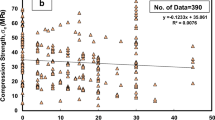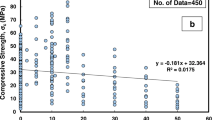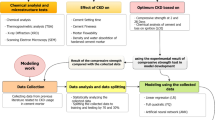Abstract
In this study, the effect of two water reducer polymers with smooth and rough surfaces on the compression strength of ordinary Portland cement (OPC) was investigated. Three different initial ratios between water and cement (w/c) 0.5, 0.6, and 1 were used in this study. The amount of polymer contents varied from 0 to 0.06% (%wt) for the cement paste with an initial w/c of 0.5. The cement paste's polymer contents ranged between 0 and 0.16% (%wt) with an initial w/c of 0.6 and 1 were investigated. SEM test was conducted to identify the impact of polymers on the behavior of cement paste. The compression strength of OPC cement increased significantly by increasing the polymer contents. Because a fiber net (netting) around cement paste particle was developed when the polymers were added to the cement paste, which leads to decrease the void between the particles, binding the cement particles, therefore, increased the viscosity and compression strength of the cement rapidly. In this analysis, the hardness of cement paste with polymer contents has been evaluated and modeled using four different model technics: more environmentally sustainable construction, and lower cost than conventional building materials and early-age strengths of the cement. To overcome the mentioned matter, this study aims to establish systematic multiscale models to predict the compression strength of cement paste containing polymers and to be used by the construction industry with no theoretical restrictions. For that purpose, comprehensive data of 280 tested cement paste modified with polymers have been conducted, analyzed, and modeled. Linear, nonlinear regression, M5P-tree, and artificial neural network (ANN) technical approaches were used for the qualifications. In the modeling process, the most relevant parameters affect the strength of cement paste, i.e., polymer incorporation ratio (0–0.16% of cement's mass), water-to-cement ratio (0.5–1), and curing ages (1–28 days). According to the correlation coefficient (R), mean absolute error, and the root-mean-square error, the compression strength of cement paste can be well predicted in terms of w/c, polymer content, and curing time using four various simulations techniques. Adding polymer creates an amorphous gel that fills the porous between the particles of the cement, which causes a reduction in the voids and porosity and enhances the dry density of the cement; subsequently, the compression strength of the cement-grouted sands increases significantly. Among the used approaches and based on the training data set, the model made based on the nonlinear regression, ANN, and M5P-tree models seems to be the most reliable models. The sensitivity investigation concludes that the polymer content is the most affected parameter for predicting the compression strength of cement paste.



















Similar content being viewed by others
Explore related subjects
Discover the latest articles, news and stories from top researchers in related subjects.Data availability
No data, models, or codes were generated or used during the study.
References
Al-Martini S, Nehdi M (2007) Impact of chemical admixtures on rheology of cement paste at high temperature. J ASTM Int 4(3):1–17
Amer AA, El-Sokkary TM, Abdullah NI (2015) Thermal durability of OPC pastes admixed with nano iron oxide. HBRC J 11(2):299–305
Ashikhmen VA, Pronina LÉ (1986) Rheological properties of dispersed cement grouts. Power Technol Eng 20(10):598–603
Burhan L, Ghafor K, Mohammed A (2019) Quantification the effect of microsand on the compression, tensile, flexural strengths, and modulus of elasticity of normal strength concrete. Geomech Geoeng 16:478–496
Burhan L, Ghafor K, Mohammed A (2020) Enhancing the fresh and hardened properties of the early age concrete modified with powder polymers and characterized using different models. Adv Civ Eng Mater 9(1):227–249
Chen JJ, Li LG, Ng PL, Kwan AKH (2017) Impact s of superfine zeolite on strength, flowability and cohesiveness of cementitious paste. Cement Concr Compos 83:101–110
Cheung J, Jeknavorian A, Roberts L, Silva D (2011) Impact of admixtures on the hydration kinetics of Portland cement. Cem Concr Res 41(12):1289–1309. https://doi.org/10.1016/j.cemconres.2011.03.005
Demir İ, Güzelkücük S, Sevim Ö (2018) Effects of sulfate on cement mortar with hybrid pozzolan substitution. Eng Sci Technol Int J 21(3):275–283
Ding W, Nguyen MD, Mohammed AS, Armaghani DJ, Hasanipanah M, Van Bui L, Pham BT (2021) A new development of ANFIS-Based Henry gas solubility optimization technique for prediction of soil shear strength. Transp Geotech 29:100579
Emad W, Salih A, Kurda R, Hassan AMT (2021a) Multivariable models to forecast the mechanical properties of polymerized cement paste. J Market Res 14:2677–2699
Emad W, Mohammed A, Kurda R (2021) Comparison between two nonlinear models to predict the stress–strain behavior, modulus of elasticity, and toughness of the flowable cement paste. Iran J Sci Technol Trans Civ Eng 46:2131–2145
Emad W, Salih A, Kurda R (2021) Experimental study using ASTM and BS standards and model evaluations to predict the compressive strength of the cement grouted sands modified with polymer. Case Stud Constr Mater 15:e00600
Emrah Demircan (2009) Modeling the properties of high-performance construction materials using artificial neural network and nonlinear relation methods, University of Houston (Master dissertation)
Ezziane K, Ngo TT, Kaci A (2014) Evaluation of rheological parameters of mortar containing various amounts of mineral addition with polycarboxylate superplasticizer. Constr Build Mater 70:549–559. https://doi.org/10.1016/j.conbuildmat.2014.07.111
Gallias JL, Kara-Ali R, Bigas JP (2000) The effect of fine mineral admixtures on water requirement of cement pastes. Cem Concr Res 30(10):1543–1549. https://doi.org/10.1016/S0008-8846(00)00380-X
Jolicoeur C, Simard MA (1998) Chemical admixture-cement interactions: phenomenology and physico-chemical concepts. Cem Concr Compos 20(2–3):87–101. https://doi.org/10.1016/S0958-9465(97)00062-0
Khudhair MHR, Elyoubi MS, Elharfi A (2017) Study of the influence of water reducing and setting retarder admixtures of polycarboxylate “superplasticizers” on physical and mechanical properties of mortar and concrete. J Mater Environ Sci 9:56–65
Khudhair MH, Elharfi A, El-Youbi MS (2018) The effect of polymeric admixtures of water reduce of superplasticizer and setting accelerator on physical properties and mechanical performance of mortars and concretes. J Environ Res 1(1):4
Kirgiz MS (2015a) Strength gain mechanisms of blended-cements containing marble powder and brick powder. KSCE J Civ Eng 19(1):165–172
Kirgiz MS (2015b) Advance treatment by nanographite for Portland pulverised fly ash cement (the class F) systems. Compos B Eng 82:59–71
Kırgız MS (2016a) Strength gain mechanism for green mortar substituted marble powder and brick powder for Portland cement. Eur J Environ Civ Eng 20(sup1):s38–s63
Kırgız MS (2016b) Fresh and hardened properties of green binder concrete containing marble powder and brick powder. Eur J Environ Civ Eng 20(sup1):s64–s101
Konsta-Gdoutos MS, Metaxa ZS, Shah SP (2010) Multi-scale mechanical and fracture characteristics and early-age strain capacity of high-performance carbon nanotube/cement nanocomposites. Cem Concr Compos 32(2):110–115. https://doi.org/10.1016/j.cemconcomp.2009.10.007
Li Y, Hishamuddin FNS, Mohammed AS, Armaghani DJ, Ulrikh DV, Dehghanbanadaki A, Azizi A (2021) The effects of rock index tests on prediction of tensile strength of granitic samples: a neuro-fuzzy intelligent system. Sustainability 13(19):10541
Mahmood W, Mohammed A, Ghafor K (2019) Viscosity, yield stress and compression strength of cement-based grout modified with polymers. Results Mater 4:100043
Mikanovic N, Jolicoeur C (2008) Influence of superplasticizers on the rheology and stability of limestone and cement pastes. Cem Concr Res 38(7):907–919. https://doi.org/10.1016/j.cemconres.2008.01.015
Mohammed AS (2014) Characterization and modeling of polymer-treated and nano particle modified sulfate contaminated soils, drilling muds, and hydraulic fracturing fluids under groundwater (Doctoral dissertation)
Mohammed AS (2017) Effect of temperature on the rheological properties with shear stress limit of iron oxide nanoparticle modified bentonite-drilling muds. Egypt J Pet 26(3):791–802
Mohammed AS (2018a) Vipulanandan models to predict the electrical resistivity, rheological properties and compression stress-strain behavior of oil well cement modified with silica nanoparticles. Egypt J Pet 27(4):1265–1273
Mohammed AS (2018b) Electrical resistivity and rheological properties of sensing bentonite-drilling muds modified with lightweight polymer. Egypt J Pet 27(1):55–63
Mohammed AS (2018c) Property correlations and statistical variations in the geotechnical properties of (CH) clay soils. Geotech Geol Eng 36(1):267–281
Mohammed A, Vipulanandan C (2018) Smart cement compression piezoresistive, stress-strain, and strength behavior with nanosilica modification. J Test Eval 47(2):1479–1501
Mohammed A, Mahmood W, Ghafor K (2020a) Shear stress limit, rheological properties and compression strength of cement-based grout modified with polymers. J Build Pathol Rehabil 5(1):3
Mohammed A, Mahmood W, Ghafor K (2020b) TGA, rheological properties with maximum shear stress and compression strength of cement-based grout modified with polycarboxylate polymers. Constr Build Mater 235:117534
Plank J, Hirsch C (2007) Impact of zeta potential of early cement hydration phases on superplasticizer adsorption. Cem Concr Res 37(4):537–542. https://doi.org/10.1016/j.cemconres.2007.01.007
Qadir W, Ghafor K, Mohammed A (2019) Evaluation the effect of lime on the plastic and hardened properties of cement mortar and quantified using Vipulanandan model. Open Eng 9(1):468–480
Rosquoët F, Alexis A, Khelidj A, Phelipot A (2003) Experimental study of cement grout: rheological behavior and sedimentation. Cem Concr Res 33(5):713–722
Saridemir M (2009) Prediction of compression strength of concretes containing metakaolin and silica fume by artificial neural networks. Adv Eng Softw 40:350–355
Sihag P, Tiwari NK, Ranjan S (2017) Modelling of infiltration of sandy soil using gaussian process regression. Model Earth Syst Environ 3(3):1091–1100. https://doi.org/10.1007/s40808-017-0357-1
Sihag P, Jain P, Kumar M (2018) Modelling of impact of water quality on recharging rate of storm water filter system using various kernel function-based regression. Model Earth Syst Environ 4(1):61–68
Soroka I, Ravina D (1998) Hot weather concreting with admixtures. Cem Concr Compos 20(2–3):129–136
Vipulanandan C, Mohammed A (2015b) Hydraulic fracturing fluid modified with nanosilica proppant and salt water for shale rocks. In: AADE national technical conference and exhibition, AADE-15-NTCE-38
Vipulanandan C, Krishnamoorti R, Mohammed A, Boncan V, Narvaez G, Head B, Pappas JM (2015) Iron nanoparticle modified smart cement for real time monitoring of ultra-deepwater oil well cementing applications. In: Offshore technology conference
Vipulanandan C, Mohammed A, Ganpatye AS (2018) Smart cement performance enhancement with nanoAl2O3 for real time monitoring applications using vipulanandan models. In: Offshore technology conference
Vipulanandan C, Mohammed A (2015a) Effect of nanoclay on the electrical resistivity and rheological properties of smart and sensing bentonite drilling muds. J Petrol Sci Eng 130:86–95
Vipulanandan C, Mohammed A (2020) Effect of drilling mud bentonite contents on the fluid loss and filter cake formation on a field clay soil formation compared to the API fluid loss method and characterized using Vipulanandan models. J Pet Sci Eng 189:107029
Yaman MA, Elaty MA, Taman M (2017) Predicting the ingredients of self-compacting concrete using artificial neural network. Alex Eng J 56(4):523–532
Yildirim G, Sahmaran M, Ahmed HU (2015) Influence of hydrated lime addition on the self-healing capability of high-volume fly ash incorporated cementitious composites. J Mater Civ Eng 27(6):04014187
Zain MFM, Abd SM (2009) Multiple regression model for compression strength prediction of high-performance concrete. J Appl Sci 9:155–160
Zeng F, Amar MN, Mohammed AS, Motahari MR, Hasanipanah M (2021) Improving the performance of LSSVM model in predicting the safety factor for circular failure slope through optimization algorithms. Eng Comput 38(3):1755–1766
Zeng J, Roy B, Kumar D, Mohammed AS, Armaghani DJ, Zhou J, Mohamad ET (2021) Proposing several hybrid PSO-extreme learning machine techniques to predict TBM performance. Eng Comput. https://doi.org/10.1007/s00366-020-01225-2
Acknowledgements
The Civil Engineering Department, University of Sulaimani, Gasin Cement Co. and Zarya Construction Co. supported this study.
Funding
No fund was received.
Author information
Authors and Affiliations
Corresponding authors
Ethics declarations
Conflict of interest
The authors declare that they have no conflict of interest.
Additional information
Publisher's Note
Springer Nature remains neutral with regard to jurisdictional claims in published maps and institutional affiliations.
Rights and permissions
Springer Nature or its licensor holds exclusive rights to this article under a publishing agreement with the author(s) or other rightsholder(s); author self-archiving of the accepted manuscript version of this article is solely governed by the terms of such publishing agreement and applicable law.
About this article
Cite this article
Mahmood, W., Mohammed, A.S., Asteris, P.G. et al. Soft computing technics to predict the early-age compressive strength of flowable ordinary Portland cement. Soft Comput 27, 3133–3150 (2023). https://doi.org/10.1007/s00500-022-07505-x
Accepted:
Published:
Issue Date:
DOI: https://doi.org/10.1007/s00500-022-07505-x




